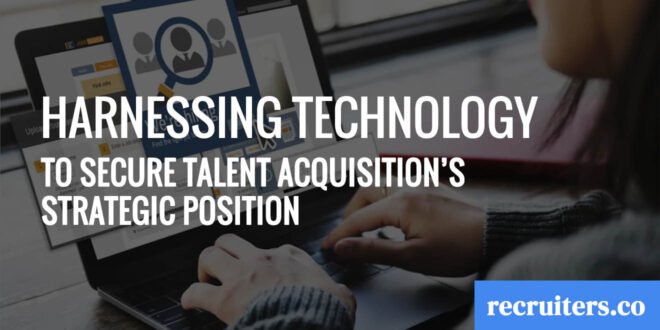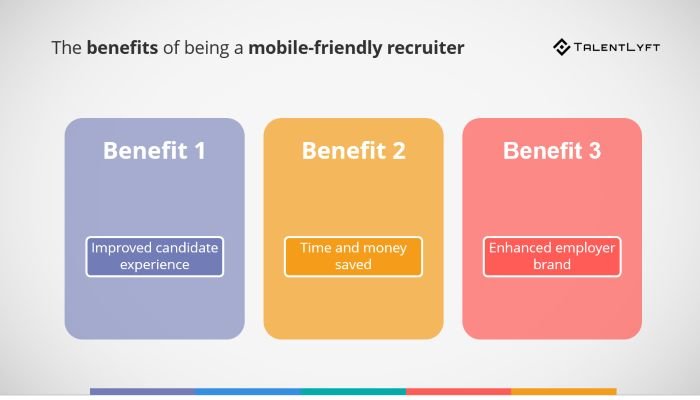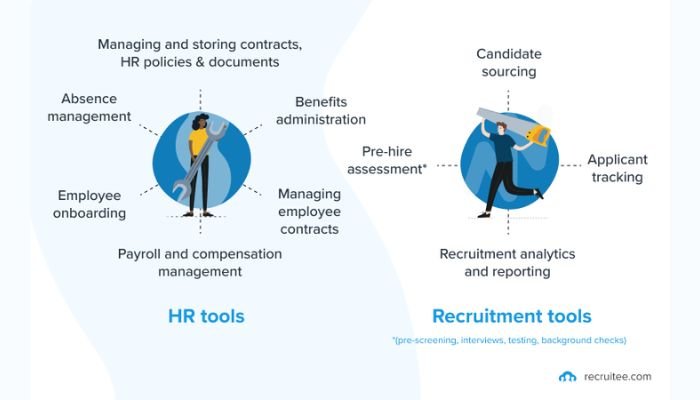How to Harness Technology to Acquire Top Talent

Recruiting and acquiring talented individuals is integral to the long-term success of any organization. Recruiting efforts are constrained by time, scope, and the quality of candidates.
Recently, however, this process has been revolutionized with the utilization of technology throughout various stages of recruitment including resume screening, personalizing communication, and engaging hiring teams.
Harnessing such technological advancements can provide organizations with an ideal platform for improving efficiency, enhancing the candidate experience, and using data to inform decision-making processes.
This article will illustrate how technology can support organizations in maximizing their strategic position in talent acquisition while maintaining a competitive advantage within their sector.
Empower Recruiters through Technological Advancements
Leveraging AI-powered tools

Leveraging the power of artificial intelligence (AI) for resume screening and candidate matching has revolutionized talent acquisition.
With AI-enabled tools, recruiters can accurately assess a vast number of available applicants in an efficient and effective manner, helping to identify best-fit candidates quickly and accurately.
Such automated processes remove human bias from job screenings, allowing companies to make informed decisions when selecting personnel.
AI technology also enables query databases of existing candidate profiles, making it simple for recruiters to extract highly relevant information with sophisticated algorithms that examine large groups of resumes within minutes.
Streamlining communication
As technology plays an increasingly crucial role in modern talent acquisition, advancements have helped recruiters to be more effective in their workflows. One of the key areas where technological innovations can revolutionize recruitment processes is by streamlining communication with automation and chatbots.
Automated assistants can help take away mundane tasks associated with interactions with candidates throughout their job search journey, such as initial screenings, scheduling interviews, or updating them on Application status. Smart Chatbots can provide round-the-clock assistance thereby improving candidate experience while reducing manual effort for recruiters.
Utilizing data analytics
Utilizing data analytics for predictive candidate sourcing can empower recruiters to take their staffing strategies to the next level. This approach allows companies to leverage AI-enabled algorithms and powerful analytics dashboards to aggregate, integrate, and visualize recruitment-related insights at a glance.
Leveraging this technology in tandem with an organization’s existing applications and databases allows them to find better talent faster — enabling tailored searches and targeted job postings that draw top candidates more effectively than the traditional effort of searching through hundreds of unstructured resumes manually.
Automating recordkeeping processes as well provides stakeholders easy access to comprehensive historical records for greater transparency when analyzing results of recruiting initiatives— clearly demonstrating the high ROI from investing in modern recruitment technologies.
Enhancing the Candidate’s Experience through Technological Innovations
Implementing mobile-friendly application processes

With a world of endless possibilities at their fingertips, today’s digital-savvy jobseekers expect technology to play a key role in the recruitment process. Implementing natural language processing (NLP) and mobile-friendly interfaces allows employers to give candidates an enhanced experience that is fast, easy, and seamless.
By simplifying complicated application forms into text boxes or drop-down menus it allows applicants to submit their information with ease on any device – from smartphones to tablets.
Additionally, implementing AngularJS or other libraries encourages smoother navigational experiences so users remain engaged with your sites longer.
Submitting resumes electronically also streamlines document management including background checks, contracts, and reference lists – meaning no more time wasted managing paper resources – which in turn helps speed up the onboarding process significantly.
Finally, equipping employers with employee tracking dashboards and effective review forms demonstrates a sincere effort to keep the candidate engaged throughout the end-to-end application cycle.
Utilizing virtual reality (VR) for immersive
In the quest for talent acquisition success, technology has all but become addictive for organizations. One area in particular that sees immense value from technological advancements is the candidate’s experience and outlook.
Utilizing virtual reality (VR) can take candidate assessments to much fairer and more immersive levels. Thanks to this, recruiters are able to expose a realistic company picture and workplace environment in real-time virtual visits at any time of day or night without the need for physical location targeting.
This discourages unavailable candidates due to distance from applying as traditional assessment locations would require them to drag across hundreds if not thousands of miles just for a few minutes interview with no assurance whatsoever of being successful.
VR technologies also fuel candidates with realistic expectations on things like office culture, team collaboration, conflict resolution, etc., further avoiding future disappointments galore for prospective employers and job applicants alike.
Personalizing communication and engagement through targeted content
Personalizing communication and engagement with a candidate help to create a better overall experience, which can greatly improve hiring outcomes. With advances in technology, this potential is even greater.
By leveraging unique profiles that assess candidates’ interests, skills, availability for shifts, or project completion times, employers can match job opportunities accordingly and be more transparent about what they expect from the selected candidate.
Employers can also use targeted content in their outreach strategy — such as serving dynamic webpages based on the candidate’s task history, creating urgent messages personalized toward available positions with specific perks, or company video-based tutorials where local experts provide personal advice to job seekers that accelerates the learning process.
Offering self-service portals for candidate updates and feedback
One way employers can leverage technology in talent acquisition to increase the efficiency and quality of candidate experience is by offering self-service portals to allow candidates to monitor progress, make updates, and provide feedback.
Self-service technology automates many common administrative tasks that normally occupy recruiters’ busy days such as confirming contact details and scheduling reference calls. Additionally, it provides a secure platform for associated paperwork such as tax forms or non-disclosure agreements.
This allows faster time-to-hire while reducing costly errors so that recruitment processes are functioning at their most agile and efficient levels.
Through direct communication between employers and candidates regarding every step of the process along with simplified access to all needs documents, self-service portals help create world-class experiences for both parties – guaranteeing the best service levels for each selectee guaranteed to be a firm fit.
Engaging Hiring Teams with Technology

Implementing applicant tracking systems (ATS) for seamless collaboration
One way to ensure talent acquisition processes are seamless and efficient is to implement Applicant Tracking Systems (ATS). An ATS centralizes and standardizes candidate data such as resumes, contact information, work experience, and interview feedback.
This makes it easy for hiring teams to collaborate across departments with their colleagues when it comes to making decisions on which candidates should be hired.
Additionally, an ATS provides a suite of tools that help make downloading files easier; keeps track of emails for follow-up communications; tracks changes made by HR personnel so no progress is lost; designates certain user roles so everyone knows the part they play in recruiting successful applicants and more! With these benefits in tow, organizations can strategically build sustainable recruitment pipelines for increased performance.
Enabling real-time feedback and evaluation through digital platforms
Digital platforms have emerged as a powerful tool for enabling hiring teams to collaborate and provide real-time feedback on applicants. Teams are able to log in and access candidate profiles remotely without needing reams of paperwork.
This allows entire teams, including potentially remote recruiters, part-time workers, or those new to the recruitment process to share useful insights during the selection process that can be tracked in an easy-to-understand fashion.
The resultant big data created through such systems further allows managers immediate access to recruitment effectiveness and measurable insight into initiatives undertaken.
Integrating digital platforms accordingly provides improved stakeholder management throughout the talent acquisition process while helping monitor opportunities where improvements can be made quickly and effectively.
Facilitating virtual interviews and panel discussions
![]()
Teams of recruiters and hiring managers across departments can use technologically advanced virtual interviewing solutions to easily converse with remote candidates.
Through one platform, groups of stakeholders are connected together for digital panels where each member can take part in real-time presentations and discussions about an applicant’s qualifications, skillset, personality traits, and goals — allowing valuable insights beyond the traditional resume review process.
This works well for dispersed teams participating in multistage interviews or offering job offer cohort days which motivate applicants to make educated talks on joining your company’s team. In order to leverage virtual interviewing for maximum impact, however, proper early preparation is vital to ensure smooth connection for both recruiters as well as recruits regardless of location.
Integrating hiring team feedback
Integrating hiring team feedback into a centralized platform can significantly improve decision-making within talent acquisition teams. This allows the inclusion of combining data from resumes, personality and skills assessments, and other communications with applicants managed in one place.
Streamlining this process avoids distracting multi-channel discussions among recruiters and hiring managers as all views can be weighed efficiently in digest form to swiftly arrive at suitable decisions. Compiling stakeholders’ comments would empower smarter choices for critical roles without any hint of bias or favoritism.
The big benefit is having actionable information leveraged for immediate use when making timely decisions on the most impactful area of an organization: its human capital investments pursuing long-term success.
Leveraging Data for Informed Decision-Making
Utilizing predictive analytics for talent forecasting and succession planning
Predictive analytics enables talent acquisition professionals to harness data and use predictive models, Machine Learning algorithms, and AI-driven strategies to anticipate future trends in the talent market.
Utilizing predictive analytics allows employers to plan ahead effectively for changing workforce needs, create a dynamic succession plan, and interview prospective candidate sources with greater precision.
This information can be further analyzed to identify patterns that shape employee retention rates as well as biases in workplace demographics by leveraging artificial intelligence tools that uncover systemic blocks which hamper diversity hiring efforts.
Analyzing candidate data to identify trends and improve hiring strategies
One of the key ways technology is being used to revolutionize talent acquisition is through data analytics. By leveraging data, recruiters can gain invaluable insight into candidate trends and make better-informed recruitment decisions.
This involves collecting important data points such as geographic information, job titles and descriptions, average salaries, and skills and experience levels among others. Analyzing this data allows hiring teams to determine trends in the competitive landscape as well as how different sources produce education leads for their company.
These insights are incredibly powerful for companies to accurately identify potential candidates that meet ideal qualifications and more strategically target individuals best suited for their roles and culture.
That being said it’s essential teams utilize tools powered by sophisticated algorithms to quickly detect legitimate trends within the analyzed datasets compared higher accurate performance metrics proactively.
Adapting to Evolving Recruiting Practices through Technology

Embracing remote and virtual recruiting strategies
Remote and virtual recruiting are increasingly important strategies for success in the talent acquisition landscape. Technologies such as video conferencing platforms, teleconferencing, and digital assessment and selection tools allow employers to virtually engage and assess potential candidates regardless of location.
Additionally, businesses can leverage online communities to widen their talent network and enable recruitment teams to connect with remote élite and diverse pools of inactive jobseekers across geographic boundaries.
Finally, digital onboarding solutions facilitate easy onboarding processes even when individual employees are operating from various locations best suits them. All these technologies combined drive efficient remote recruiting strategies that further aid an organization in sourcing skilled talent in a cost-effective manner.
Leveraging social media platforms
As recruiting strategies evolve, so must our adapted technology to keep up. Leveraging the widespread reach of social media is critical for engaging with and sourcing potential talent, as it increases brand visibility and creates personal connections on a larger scale than ever before.
Social platforms are also great for employers to showcase their value proposition and mission statements above the market competition while targeting individuals who would make quality candidates.
Companies should continuously research new trends in social media part designs and methods such as AI-powered tags targeted for users’ complete profile pictures in order to advertise job postings.
Conclusion
In conclusion, harnessing technology has profoundly enhanced the talent acquisition process from end to end. By implementing AI-powered tools and leveraging data analytics in recruitment, employers can improve their decision-making capabilities and ensure top-notch candidate experience.
Automation helps recruiters enhance their productivity as they navigate complex tasks ranging from matchmaking amiable candidates with potential jobs to anticipating recruitment trends.
Additionally, utilizing advanced technological solutions such as VR interviews and remote processes has enabled recruiters to remain flexible yet efficient in an ever-evolving competitive landscape. Clearly, investing in technological advancements goes a long way when it comes to maintaining strategic positioning for any organization’s talent acquisition needs.
- Mastering Internal Mobility: A Comprehensive Guide to Success - August 10, 2023
- Effective Recruiting Strategies in a Competitive Sales Labor Market - July 27, 2023
- 6 Essential Factors to Attract Top Talent - July 19, 2023
